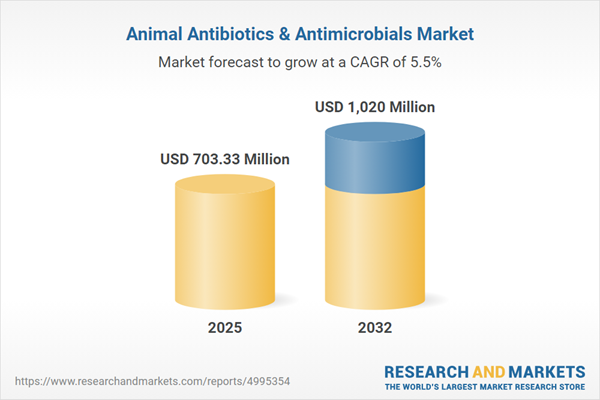Speak directly to the analyst to clarify any post sales queries you may have.
The animal antibiotics & antimicrobials market is evolving rapidly as industry policies, technological solutions, and consumer standards reshape strategies across animal health. Senior decision-makers require precise, up-to-date insights to navigate this complex landscape and drive informed actions.
Market Snapshot: Animal Antibiotics & Antimicrobials
The animal antibiotics & antimicrobials market grew from USD 667.23 million in 2024 to USD 703.33 million in 2025, with an expected CAGR of 5.45% that will propel it to USD 1.02 billion by 2032. Expansion is being shaped by stricter regulations, new technologies, and heightened consumer demand for transparency throughout livestock production and pharmaceutical supply chains.
Scope & Segmentation
This executive market research report offers deep segmentation and comprehensive regional insights for strategic planning:
- Class: Aminoglycosides (gentamicin, neomycin, streptomycin), Beta Lactams (cephalosporins, penicillins), Fluoroquinolones (ciprofloxacin, enrofloxacin, marbofloxacin), Macrolides (erythromycin, spiramycin, tilmicosin, tylosin), Sulfonamides (sulfadimethoxine, sulfamethazine), Tetracyclines (chlortetracycline, doxycycline, oxytetracycline, tetracycline)
- Animal Species: Aquaculture, cattle, companion animals, poultry, swine
- Administration Route: Feed additives, in ovo, injectable, oral, topical, water soluble
- Formulation: Bolus, liquid, powder, premix
- Distribution Channel: Feed mills, online, pharmacies, veterinary clinics
- Regions: Americas (United States, Canada, Mexico, Brazil, Argentina, Chile, Colombia, Peru), Europe/Middle East/Africa (United Kingdom, Germany, France, Russia, Italy, Spain, Netherlands, Sweden, Poland, Switzerland, United Arab Emirates, Saudi Arabia, Qatar, Turkey, Israel, South Africa, Nigeria, Egypt, Kenya), Asia-Pacific (China, India, Japan, Australia, South Korea, Indonesia, Thailand, Malaysia, Singapore, Taiwan)
- Key Companies: American Regent Inc., Ayurvet, Bayer AG, Boehringer Ingelheim GmbH, Ceva Sante Animale, Chanelle Pharma, Dechra Pharmaceuticals PLC, Eco Animal Health Group PLC, Elanco Animal Health Incorporated, Eli Lilly and Company, Endovac Animal Health, LLC, Hester Biosciences Limited, Hipra Laboratories S.A., Inovet Group, Neogen Corporation, Norbrook Laboratories Ltd., Novartis AG, Phibro Animal Health Corporation
Key Takeaways for Decision-Makers
- Regional regulatory shifts require tailored compliance strategies and ongoing risk assessment, as standards vary across mature and emerging markets.
- Growth in aquaculture and companion animal segments is driving demand for innovative water-soluble and injectable formulations, expanding portfolio needs for manufacturers.
- Diagnostic technologies and digital monitoring solutions are enabling targeted dosing and microbial surveillance, directly supporting reduction in broad-spectrum antibiotic reliance.
- Consumer demand for transparency and sustainability solutions, such as antibiotic-free labeling and traceability, is influencing procurement and value chain strategies.
- Strategic alliances—spanning contract manufacturing, R&D, and supply chain partnerships—are accelerating access to novel compounds and production efficiencies.
- Adaptation to supply chain volatility is essential as companies diversify sourcing and build domestic capabilities in response to evolving market dynamics and trade policies.
Tariff Impact: Navigating US Policy Effects
Recent United States import tariffs on animal antibiotic and antimicrobial products have reconfigured industry cost structures and influenced global sourcing strategies. Firms are exploring alternative procurement channels, recalibrating supply routes, and shifting production capacity domestically or to low-tariff regions. Scenario planning and collaborative risk management have become central to preserving competitiveness and margin stability in this shifting landscape.
Methodology & Data Sources
This report applies a robust methodology, blending secondary research from industry journals, regulatory databases, and filings with targeted interviews of senior executives, veterinary specialists, and policy experts. Analytical rigor is upheld through triangulation of financial disclosures, clinical trials, and patent filings, ensuring valid, comprehensive insights for each segment and region.
Why This Report Matters for Animal Antibiotics & Antimicrobials
- Equips senior leadership with actionable frameworks to navigate compliance, technological integration, and evolving consumer demands in the sector.
- Highlights strategic opportunities arising from regulatory harmonization and digital innovation, supporting resilient and sustainable growth pathways.
- Delivers reliable, data-driven intelligence for evaluating risk, optimizing supply chains, and developing next-generation therapeutic portfolios.
Conclusion
Industry transformation in animal antibiotics and antimicrobials is accelerating, driven by shifts in policy, consumer expectations, and technology. This report positions senior decision-makers to capitalize on emerging trends and steer their organizations through a dynamic future.
Additional Product Information:
- Purchase of this report includes 1 year online access with quarterly updates.
- This report can be updated on request. Please contact our Customer Experience team using the Ask a Question widget on our website.
Table of Contents
3. Executive Summary
4. Market Overview
7. Cumulative Impact of Artificial Intelligence 2025
Companies Mentioned
The companies profiled in this Animal Antibiotics & Antimicrobials market report include:- American Regent Inc.
- Ayurvet
- Bayer AG
- Boehringer Ingelheim GmbH
- Ceva Sante Animale
- Chanelle Pharma
- Dechra Pharmaceuticals PLC
- Eco Animal Health Group PLC
- Elanco Animal Health Incorporated
- Eli Lilly and Company
- Endovac Animal Health, LLC
- Hester Biosciences Limited
- Hipra Laboratories, S.A.
- Inovet Group
- Neogen Corporation
- Norbrook Laboratories Ltd.
- Novartis AG
- Phibro Animal Health Corporation
Table Information
| Report Attribute | Details |
|---|---|
| No. of Pages | 182 |
| Published | November 2025 |
| Forecast Period | 2025 - 2032 |
| Estimated Market Value ( USD | $ 703.33 Million |
| Forecasted Market Value ( USD | $ 1020 Million |
| Compound Annual Growth Rate | 5.4% |
| Regions Covered | Global |
| No. of Companies Mentioned | 19 |









